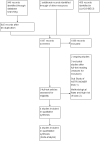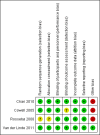Statins for aortic valve stenosis
- PMID: 27594276
- PMCID: PMC6457620
- DOI: 10.1002/14651858.CD009571.pub2
Statins for aortic valve stenosis
Abstract
Background: Aortic valve stenosis is the most common type of valvular heart disease in the USA and Europe. Aortic valve stenosis is considered similar to atherosclerotic disease. Some studies have evaluated statins for aortic valve stenosis.
Objectives: To evaluate the effectiveness and safety of statins in aortic valve stenosis.
Search methods: We searched the Cochrane Central Register of Controlled Trials (CENTRAL), MEDLINE, Embase, LILACS - IBECS, Web of Science and CINAHL Plus. These databases were searched from their inception to 24 November 2015. We also searched trials in registers for ongoing trials. We used no language restrictions.
Selection criteria: Randomised controlled clinical trials (RCTs) comparing statins alone or in association with other systemic drugs to reduce cholesterol levels versus placebo or usual care.
Data collection and analysis: Primary outcomes were severity of aortic valve stenosis (evaluated by echocardiographic criteria: mean pressure gradient, valve area and aortic jet velocity), freedom from valve replacement and death from cardiovascular cause. Secondary outcomes were hospitalisation for any reason, overall mortality, adverse events and patient quality of life.Two review authors independently selected trials for inclusion, extracted data and assessed the risk of bias. The GRADE methodology was employed to assess the quality of result findings and the GRADE profiler (GRADEPRO) was used to import data from Review Manager 5.3 to create a 'Summary of findings' table.
Main results: We included four RCTs with 2360 participants comparing statins (1185 participants) with placebo (1175 participants). We found low-quality evidence for our primary outcome of severity of aortic valve stenosis, evaluated by mean pressure gradient (mean difference (MD) -0.54, 95% confidence interval (CI) -1.88 to 0.80; participants = 1935; studies = 2), valve area (MD -0.07, 95% CI -0.28 to 0.14; participants = 127; studies = 2), and aortic jet velocity (MD -0.06, 95% CI -0.26 to 0.14; participants = 155; study = 1). Moderate-quality evidence showed no effect on freedom from valve replacement with statins (risk ratio (RR) 0.93, 95% CI 0.81 to 1.06; participants = 2360; studies = 4), and no effect on muscle pain as an adverse event (RR 0.91, 95% CI 0.75 to 1.09; participants = 2204; studies = 3; moderate-quality evidence). Low- and very low-quality evidence showed uncertainty around the effect of statins on death from cardiovascular cause (RR 0.80, 95% CI 0.56 to 1.15; participants = 2297; studies = 3; low-quality evidence) and hospitalisation for any reason (RR 0.84, 95% CI 0.39 to 1.84; participants = 155; study = 1; very low-quality evidence). None of the four included studies reported on overall mortality and patient quality of life.
Authors' conclusions: Result findings showed uncertainty surrounding the effect of statins for aortic valve stenosis.The quality of evidence from the reported outcomes ranged from moderate to very low. These results give support to European and USA guidelines (2012 and 2014, respectively) that so far there is no clinical treatment option for aortic valve stenosis.
Conflict of interest statement
There is no conflict of interest in this review.
Figures










Comment in
-
Statins for aortic valve stenosis.Sao Paulo Med J. 2016 Nov-Dec;134(6):555-556. doi: 10.1590/1516-3180.20161346T1. Sao Paulo Med J. 2016. PMID: 28076633 Free PMC article.
References
References to studies included in this review
Chan 2010 {published data only}
-
- Chan KL, Teo K, Dumesnil JG, Ni A, Tam J, ASTRONOMER Investigators. Effect of lipid lowering with rosuvastatin on progression of aortic stenosis: results of the aortic stenosis progression observation: measuring effects of rosuvastatin (ASTRONOMER) trial. Circulation 2010;121(2):306‐14. - PubMed
Cowell 2005 {published data only}
-
- Cowell SJ, Newby DE, Prescott RJ, Bloomfield P, Reid J, Northridge DB, et al. Scottish Aortic Stenosis and Lipid Lowering Trial, Impact on Regression (SALTIRE) Investigators. A randomized trial of intensive lipid‐lowering therapy in calcific aortic stenosis. New England Journal of Medicine 2005;352:2389‐97. - PubMed
Rossebø 2008 {published data only}
-
- Rossebø AB, Pedersen TR, Boman K, Brudi P, Chambers JB, Egstrup K, et al. SEAS Investigators. Intensive lipid lowering with simvastatin and ezetimibe in aortic stenosis. New England Journal of Medicine 2008;359(13):1343‐56. - PubMed
Van der Linde 2011 {published data only}
-
- Linde D, Yap SC, Dijk AP, Budts W, Pieper PG, Burgh PH, et al. Effects of rosuvastatin on progression of stenosis in adult patients with congenital aortic stenosis (PROCAS Trial). American Journal of Cardiology 2011;108(2):265‐71. - PubMed
References to studies excluded from this review
Chan 2011 {published data only}
-
- Chan KL, Dumesnil JG, Tam J, Ni A, Teo K. Effect of rosuvastatin on C‐reactive protein and progression of aortic stenosis. American Heart Journal 2011;161(6):1133‐9. - PubMed
Ditchl 2008 {published data only}
-
- Ditchl W, Alber HF, Feuchtner GM, Hintringer F, Reinthaler M, Bartel T, et al. Prognosis and risk factors in patients with asymptomatic aortic stenosis and their modulation by atorvastatin (20 mg). American Journal of Cardiology 2008;102(6):743‐8. - PubMed
Panahi 2013 {published data only}
-
- Panahi Y, Sahebkar A, Taghipour HR, Dadjou Y, Pishgoo B, Rakhshankhah AS. Atorvastatin therapy is not associated with slowing the progression of aortic stenosis: findings of a randomized controlled trial. Clinical Laboratory 2013;59(3‐4):299‐305. - PubMed
References to ongoing studies
Kindo 2008 {published data only}
-
- Kindo M. Interest of Statin in Surgical Aortic Stenosis: From Myocardial Preconditioning to Ventricular Reverse Remodeling. ClinicalTrials.gov: NCT00811330.
Schuler 2005 {published data only}
-
- Schuler G. Statin Therapy in Asymptomatic Aortic Stenosis. ClinicalTrials.gov: NCT00176410.
Additional references
Antman 1992
-
- Antman EM, Lau J, Kupelnick B, Mosteller F, Chalmers TC. A comparison of results of meta‐analyses of randomized control trials and recommendations of clinical experts. Treatments for myocardial infarction. JAMA 1992;268:240‐8. - PubMed
Canterin 2009
-
- Canterin FA, Leiballi E, Enache R, Popescu BA, Roçsca M, Cervesato E, et al. Hydroxymethylglutaryl coenzime‐A reductase inhibitors delay the progression of rheumatic aortic valve stenosis: a long‐term echocardiographic study. Journal of the American College of Cardiology 2009;53:1874‐9. - PubMed
Canterin 2010
Dweck 2012
-
- Dweck MR, Boon NA, Newby DE. Calcific aortic stenosis. Journal of the American College of Cardiology 2012;60(19):1854–63. - PubMed
GRADE PRO 2011 [Computer program]
-
- GRADE Working Group. GRADE Profiler. Version Version 3.2 for Windows. Brozek J, Oxman A, Schünemann H, 2011.
Higgins 2011
-
- Higgins JPT, Green S. Cochrane Handbook for Systematic Reviews of Interventions Version 5.1.0 [updated March 2011]. The Cochrane Collaboration, 2011. Available from www.cochrane‐handbook.org.
Kapur 2008
Katz 2010
-
- Katz M, Tarasoutchi F, Grinberg M. Severe aortic stenosis in asymptomatic patients: the dilemma of clinical versus surgical treatment. Arquivos Brasileiros de Cardiologia 2010;95(4):542‐6. - PubMed
Liebe 2006
-
- Liebe V, Brueckmann M, Borggrefe M, Kaden JJ. Statin therapy of calcific aortic stenosis: hype or hope?. European Heart Journal 2006;27:773‐8. - PubMed
Macedo 2014
Mancini 2011
-
- Mancini GBJ, Baker S, Bergeron J, Fitchett D, Frohlich J, Genest J, et al. Diagnosis, prevention, and management of statin adverse effects and intolerance: proceedings of a Canadian Working Group Consensus Conference. Canadian Journal of Cardiology 2011;27(5):635‐62. - PubMed
Moher 2009
-
- Moher D, Liberati A, Tetzlaff J, Altman DG. Preferred Reporting Items for Systematic Reviews and Meta‐Analyses: The PRISMA Statement. Annals of Internal Medicine 2009;151(4):264‐9. - PubMed
Nishimura 2014
-
- Nishimura RA, Otto CM, Bonow RO, Carabello BA, Erwin JP III, Guyton RA, et al. 2014 AHA/ACC Guideline for the Managementof Patients With Valvular Heart Disease. Journal of the American College of Cardiology 2014;63(22):e57–185. - PubMed
Novaro 2001
-
- Novaro GM, Tiong IY, Pearce GL, Lauer MS, Sprecher DL, Griffin BP. Effect of hydroxymethylglutaryl coenzyme A reductase inhibitors on the progression of calcific aortic stenosis. Circulation 2001;104:2205‐9. - PubMed
Oxman1993
-
- Oxman AD, Guyatt GH. The science of reviewing research. Annals of the New York Academy of Sciences 1993;703:125‐33. - PubMed
Parolari 2011
-
- Parolari A, Tremoli E, Cavallotti L, Trezzi M, Kassem S, Loardi C, Veglia F, et al. Do statins improve outcomes and delay the progression of non rheumatic calcific aortic stenosis?. Heart 2011;97(7):523‐9. - PubMed
Pedersen 2008
-
- Pedersen TR. Overview of clinical trials on calcific stenosis. European Heart Journal 2008;10 (Supplement E):E32‐40.
Rajamannan 2008
-
- Rajamannan NM. Update on the pathophysiology of aortic stenosis. European Heart Journal 2008;10(E Supl):4‐10.
RevMan 2014 [Computer program]
-
- The Cochrane Collaboration. Review Manager (RevMan). Version 5.3. Copenhagen: The Nordic Cochrane Centre, The Cochrane Collaboration, 2014.. The Cochrane Collaboration, 2014.
Ridker 2008
-
- Ridker PM, Danielson E, Fonseca FAH, Genest J, Gotto AMJ, Kastelein JJP, et al. Rosuvastatin to prevent vascular events in men and women with elevated C‐reactive protein. New England Journal of Medicine 2008;359(21):2195‐207. - PubMed
Russo 2014
Schulz 2010
-
- Schulz KF, Altman DG, Moher D, CONSORT Group. CONSORT 2010 Statement: updated guidelines for reporting parallel group randomized trials. Annals of Internal Medicine 2010;152(11):726‐32. - PubMed
Siu 2010
-
- Siu SC, Silversides CK. Bicuspid valve aortic disease. Journal of the American College of Cardiology 2010;55:2789‐800. - PubMed
Stone 2014
-
- Stone NJ, Robinson J, Lichtenstein AH, Bairey Merz CN, Blum CB, Eckel RH, et al. 2013 ACC/AHAguideline on the treatment of blood cholesterol to reduce atherosclerotic cardiovascular risk in adults: a report of the American College of Cardiology/American Heart Association Task Force on Practice Guidelines. Circulation 2014;129(Suppl 2):S1–45. - PubMed
Teo 2011
-
- Teo KK, Corsi DJ, Tam JW, Dumesnil JG, Chan KL. Lipid lowering on progression of mild to moderate aortic stenosis: meta‐analysis of the randomized placebo controlled clinical trials on 2344 patients. Canadian Journal of Cardiology 2011;27(6):800‐8. - PubMed
Vahanian 2010
-
- Vahanian A, Otto CM. Risk stratification of patients with aortic stenosis. European Heart Journal 2010;31:416‐23. - PubMed
Vahanian 2012
-
- Vahanian A, Alfieri O, Andreotti F, Antunes MJ, Esquivias GB, Baumgartner H, et al. Guidelines on the management of valvular heart disease (version 2012). European Heart Journal 2012;33(19):2451‐96. - PubMed
Vaughan 2004
-
- Vaughan CJ, Gotto AM J. Update on Statins:2003. Circulation 2004;110:886‐92. - PubMed
Publication types
LinkOut - more resources
Full Text Sources
Other Literature Sources
Medical

